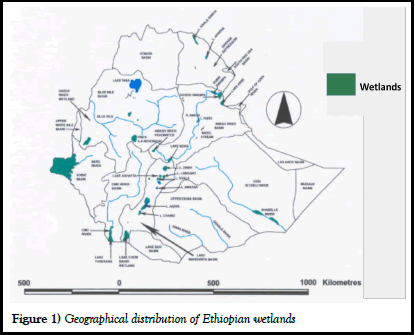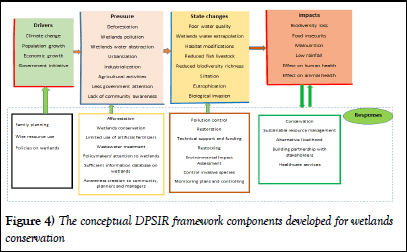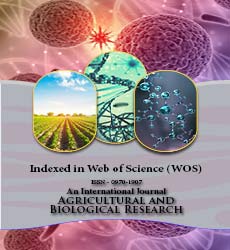Agricultural and Biological Research
RNI # 24/103/2012-R1
Research Article - (2025) Volume 41, Issue 4
Wetlands are responsible for providing provisioning, regulatory, supporting, and cultural services. Due to many challenges, wetlands have become severely degraded. The understanding of wetlands and their values is inadequate. There is no evidence indicating the development of indicators for wetlands conservation. This study's purpose was to emphasize the importance of integrating the DPSIR framework with some developed environmental indicators for wetlands conservation. A total of 135 papers were collected using web-based search engines. The DPSIR framework analysis of Ethiopian wetlands degradation is being carried out using scientific knowledge and documented literature. In Ethiopia, besides of high cost of intervention on degraded wetlands, the issue has gotten less attention; no quick and one-off solution to alleviate these problems, there is little or lack of research, community awareness, knowledge of planners and resource managers and policy gaps. The local community's involvement in wetlands conservation is limited. To develop some important and applicable indicators based on the collected data, the application of the DPSIR model was quite essential. Based on professional experience and literature review, some steps were used for developing some relevant indicators for sustainable wetlands conservation. Some applicable components of the conceptual framework were used as DPSIR indicators. The conceptual framework was designed to enable an understanding of the causal relationships between driving forces and socioeconomic impacts. Baseline information from the developed DPSIR indicators can be utilized to guide management actions in implementing short or long-term responses to conservation measures.
Conservation; DPSIR; Indicators; Wetlands
Wetlands account for 890 million hectares (6%) of the global land surface. However, an estimated 50% of the world's wetlands have been lost in the last 50 years [1]. Ethiopia's landmass is made up of 2% of wetlands [2]. The country has two main freshwater resources: Surface water and groundwater. Surface water is composed of lakes, rivers, and wetlands. Gebresilassie et al., reported that Ethiopia has more than 58 wetlands that are composed of various landscapes, such as grasslands, grazing land, ground forest, woodland, and swamps (Figure 1). Ethiopia has a vast variety of wetlands, with the only exceptions being coastal and marine-related and wide swamp forest complexes [3-5].

Figure 1) Geographical distribution of Ethiopian wetlands
The supply of wetlands resources, which provide provisioning, regulating, supporting, and cultural ecosystem services, is crucial for riparian communities [6-8]. For example, wetlands provide or serve as a food source, water source, income source (eco-tourism), crop production, fish livestock, plant medication, fuel wood source; regulating services such as water purification, water storage and supply, sediment accretion, coastal flood control, pollutants retentions (microclimate regulation; carbon sequestration); supporting services like biogeochemical cycling, soil formation, pollination, shelter and care for diverse flora and fauna such as fungi, bacteria, phytoplankton, macrophytes, weed bed fauna, zooplankton, amphibians, reptiles and waterfowl and important for biodiversity and wildlife conservation [9-12]. Wetlands products are utilized as sources of cultural resources, spiritual services, house construction, educational and research services [13].
However, Ethiopian wetlands are facing many challenges and become heavily degraded due to wide driving forces or socioeconomic activities held on or nearby their catchments and driving factors include anthropogenic and natural forces [14]. In Ethiopia, the management of wetlands was compromised by the general public and decision-makers [15]. Different approaches can be used to model environmental problems and socio-economic factors. The Driver- Pressure-State-Impact-Response (DPSIR) framework is the most commonly used model as a tool for integrating socioeconomic activities that could affect the wetlands ecosystem by identifying all driving factors (Figure 2). The DPSIR framework has a limited application in developing countries. The DPSIR framework has the potential to be utilized effectively as a systematic tool for decision and policymakers in wetlands conservation. More efforts are being made to address the degradation of wetlands in Ethiopia. Developing indicators for wetlands conservation using the DPSIR framework is not suggested by any evidence. This study is the first to develop DPSIR indicators for wetlands conservation in Ethiopia. Therefore, the aim of this review was; to highlight the importance of integrating the DPSIR framework with environmental indicators for wetlands conservation and to identify the current gaps in scientific investigations and provide suggestions for further studies that will promote a detail understanding of wetlands conservation through the application of DPSIR indicators.

Figure 2) A self-creation of DPSIR framework of wetlands degradation
The study has been conducted between May 12-August 16, 2022. Google Scholar, PubMed and SCOPUS were mainly used for web searching of peerreviewed articles. Totally, 135 papers were collected (Figure 3). To collected data, important keywords mainly “Wetlands”, “Wetlands in Ethiopia”, “Wetlands degradation” and “Wetlands ecosystem service” were used in the search engines databases. The focus of this study was published papers. The study period of peer-reviewed articles was left open-ended to permit for an applicable amount of literatures to be included. Throughout the review, all searches and the review may have a limitation according to the following considerations; published literatures may be omitted due to a lack of a linkage with the keywords, all used literatures were only in the English versions, some papers may not available due to closed or limited access to articles, others were not catalogued in these electronic databases and lastly online available MSc and PhD thesis works were not included.

Figure 3) A personal creation of the flowchart representing the methodology of the review
Depending on the scientific knowledge and documented literatures, the Driver-Pressure-State-Impact-Response (DPSIR) framework analysis of Ethiopian wetlands degradation is analyzed. Drivers are hydrological and socioeconomic forces such as climate change, population growth, economic growth and government initiative (policy changes) [16,17]. This could be the reason for high cost of intervention on degraded wetlands, no quick and one-off solution to alleviate problems, little or lack of research, community awareness, knowledge of planners and resource managers and why Ethiopia has yet to ratify and implement the Ramsar convention. Pressures entertain human activities which directly contribute to wetlands degradation include deforestation or improper agricultural practices and expansions, urbanization, industrialization, recurrent drought, over extrapolation of wetland water, increase fish harvesting, lack of knowledge and awareness and weak policies on wetlands [18,19]. This may be due to the absence of a stand-alone national wetlands policy or strategy and the existing policies and laws have not adequately addressed the wetlands issue, and even some laws are contradicting the wise use of wetlands.
State changes of wetlands are existing environmental conditions affected by driving forces and may include wetlands size reduction, reduced water quality, habitat modification, reduced biodiversity richness, reduced fish livestock, biological invasions (invasive alien species), eutrophication and siltation or sedimentation [20]. This would happen due to improper intervention of the driving forces. The possible impacts of wetland degradation are direct and indirect effects of wetlands degradation and comprise loss of biodiversity, lack of food and food insecurity or malnutrition, climatic disturbance, low precipitation pattern and effect on the health of organisms (humans and animals). Absence of adequate protocols for assessment, monitoring and inventory of wetlands, sufficient formal institutional setup and legal framework and lacks of specialized experts in wetlands assessment and management may aggravate wetlands degradation. Finally, response to wetlands fragmentation includes human mitigation measures to overcome wetlands degradation and conserve wetlands are preferable to be applied to driving forces to alleviate pressures, state and impact. Ways used to reverse existing wetlands degradation which may include intervening in Driver-Pressure-Impact-State change factors as well as implementing sustainable resource management and conservation practice, technical support, funding, training and awareness creation or adequate knowledge on the status and functioning of wetlands, sufficient information database on wetlands, national inventories and National directory of wetlands, political conviction, prioritization and management plan for wetlands, continuous monitoring plan for wetlands and upstreamdownstream users relation, carrying out Environmental Impact Assessment (EIA) for developmental activities and strengthening and building partnership with stakeholders.
Following reviewing of literatures, to develop some important and applicable environmental indicators, DPSIR model was applied. The first outcome of DPSIR model and developed indicators was a conceptual framework of the DPSIR components and interaction between each identified component of the model (Figure 4 and Table 1). The conceptual framework was done in a way which enables an understanding of the causalrelationships between driving forces and socioeconomic impacts. Then, the preliminary list of environmental indicators for sustainable management and conservation of wetlands were identified. This was done based on professional experience and literature review and first, some steps were used for developing relevant indicators such as, identifying all the proxies which state a specific management challenge or wetlands degradation, sorting these identified proxies into DPSIR framework categories, establishing a linkage between the different components of DPSIR in terms of a conceptual model, assigning an indicator for each category of the developed conceptual model. Then, each component of the conceptual framework, not all, was taken as environmental indicator. Generally speaking, the overall effectiveness of the DPSIR framework can be maximized and should be integrated with a set of developed indicators for each category of DPSIR framework. However, further studies are necessary to build a concrete base of applicable and wise indicators for wetlands conservation.

Figure 4) The conceptual DPSIR framework components developed for wetlands conservation
| DPSIR framework | DPSIR component | Developed DPSIR indicator |
| Driver | Climate change | Climate change report (IPCC) |
| Population growth | The fertility rate of the population (Central statistics agency reports) | |
| Economic growth | GDP reports | |
| Government initiative | Standalone policies and conventions on wetlands (Ramsar convention ratification and development of wetlands policy) | |
| Pressure | Deforestation | Area of cleared area |
| Improper agricultural practices and expansions | Soil quality (decreased soil fertility) | |
| Urbanization | Number of people in urban areas | |
| Industrialization | Number of industries in the catchments of wetlands | |
| Absence of appropriate policy | Absence of policies on wetlands | |
| Natural disaster (recurrent drought) | Shortage of water | |
| Wetlands water abstraction | The water content of wetlands | |
| Increase fish harvesting | Food shortage | |
| Overgrazing | Number of animals near the wetland areas | |
| Lack of knowledge and awareness of wetlands | Lack of wetlands common ownership | |
| State | Wetlands size reduction | Reduced catchment size |
| Poor water quality | Deviation from standard guideline values | |
| Habitat modification | Species distribution | |
| Reduced biodiversity richness | Richness indexes | |
| Reduced fish livestock | Overfishing | |
| Biological invasions (invasive alien species) | Presence of invasive species | |
| Eutrophication | Presence of algal bloom | |
| Siltation | Sedimentation | |
| Impact | Loss of biodiversity | Extinction of organisms |
| Food insecurity or malnutrition | Shortage of food surplus | |
| Climatic disturbance | Climate change reports (CO2 and CH4 build up in the atmosphere) | |
| Effect on the hydrological cycle and rainfall pattern | Low annual rainfall | |
| Effect on the health of organisms (humans and animals) | Human and animal illness and death | |
| Response | Family planning | Low fertility rate |
| Wise resource use | Sustainable use of resources | |
| Policies on wetlands | Establishment of national inventories, a national directory of wetlands and established political convictions (signatories of conventions) | |
| Afforestation | Tree covered area (catchment) | |
| Wetlands conservation | Number of protected areas | |
| Limited use of artificial fertilizers | Use of natural fertilizer | |
| Wastewater treatment | Low level of pollutants | |
| Policymakers’ attention to wetlands | Signing convention of wetlands (Ramsar convention) and prioritization and management plan for wetlands | |
| Awareness creation to community and planners and managers | Number of awareness-raising materials distributed, number of awareness creation seminars and workshops, establishment of wetland clubs or groups and number of sessions for environmental education | |
| Pollution control | Application of pollution prevention and control measures | |
| Restoration | Restoration of damaged wetlands, number of projects on wetlands and number of restored damaged wetlands | |
| Technical support and funding | Number of workshops on wetlands and intergovernmental collaborations | |
| Preliminary inventory and environmental impact assessment | Number of firms around the catchment of wetlands with EIA inventory or report | |
| Restocking | Increase of fish population and harvesting | |
| Control invasive species | Physical, mechanical, biological and chemical measures taken | |
| Monitoring and controlling | Environmental quality and continuous monitoring plan of wetlands and upstream-downstream users relation | |
| Alternative livelihood | The annual number of newly generated jobs | |
| Building and strengthening partnerships with stakeholders | Panel discussion on wetlands issue | |
| Healthcare services | Health service coverage | |
| Sustainable resource management and conservation practice | Constant use of resources in the present and future | |
| Sufficient information database on wetlands | Number of damaged and healthy wetlands |
TABLE 1 DPSIR framework components and developed indicators for wetlands conservation
Ethiopian wetlands are facing many challenges. Depending on the scientific knowledge and documented literatures, the Driver-Pressure-State-Impact- Response (DPSIR) framework analysis of Ethiopian wetlands degradation are analyzed. This review has shown studies deal with scientific information on Ethiopian wetlands status is much needed. Some steps were used for developing relevant environmental indicators based on professional experience and literature review. The application DPSIR framework can be enhanced by developing environmental indicators. The review will contribute to indicating the effectiveness of developed DPSIR framework indicators for wetlands conservation. Through the application of the DPSIR approach, this review may be important for future investigators and stakeholders, managers, planners and policymakers in Ethiopia and other parts of the world to implement either short-term or long-term plans, policies, programmers and strategies in wetlands degradation intervention and conservation. Therefore, these developed DPSIR indicators would be an input for planners and decision-makers for wetlands conservation.
Conceptualization: BAM.
Developing methods: BAM, SME and TSA.
Data analysis: BAM, SME, TSA.
Preparation of figures and tables: BAM. Writing: BAM, SME, TSA.
All the authors have read and agreed to the final version in the publication of the review.
The review did not receive any external funding.
The authors declare that, no conflict of interest.
Data sharing is not applicable to this article as no datasets were generated or analyzed during the current study.
Received: 23-Jan-2024, Manuscript No. AGBIR-24- 125782; , Pre QC No. AGBIR-24- 125782 (PQ); Editor assigned: 25-Jan-2024, Pre QC No. AGBIR-24- 125782 (PQ); Reviewed: 08-Feb-2024, QC No. AGBIR-24- 125782; Revised: 11-Jul-2025, Manuscript No. AGBIR-24- 125782 (R); Published: 18-Jul-2025, DOI: 10.37532/0970-1907.25.41(4):1-5
